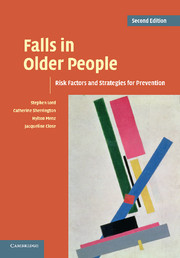Book contents
- Frontmatter
- Contents
- Preface
- Acknowledgements
- Part I Epidemiology and risk factors for falls
- 1 Epidemiology of falls and fall-related injuries
- 2 Postural stability and falls
- 3 Gait characteristics and falls
- 4 Sensory and neuromuscular risk factors for falls
- 5 Psychological factors and falls
- 6 Medical risk factors for falls
- 7 Medications as risk factors for falls
- 8 Environmental risk factors for falls
- 9 The relative importance of falls risk factors: an evidence-based summary
- Part II Strategies for prevention
- Part III Research issues in falls prevention
- Index
- References
9 - The relative importance of falls risk factors: an evidence-based summary
Published online by Cambridge University Press: 03 May 2010
- Frontmatter
- Contents
- Preface
- Acknowledgements
- Part I Epidemiology and risk factors for falls
- 1 Epidemiology of falls and fall-related injuries
- 2 Postural stability and falls
- 3 Gait characteristics and falls
- 4 Sensory and neuromuscular risk factors for falls
- 5 Psychological factors and falls
- 6 Medical risk factors for falls
- 7 Medications as risk factors for falls
- 8 Environmental risk factors for falls
- 9 The relative importance of falls risk factors: an evidence-based summary
- Part II Strategies for prevention
- Part III Research issues in falls prevention
- Index
- References
Summary
In this chapter, we have pooled the findings from published studies cited in Chapters 1 to 8 that have specifically addressed falls risk in older people. However, rather than simply listing the many and varied socio-demographic, physiological, psychological, health and environmental factors that have been posited as important falls risk factors, we have rated each factor according to the strength of the published evidence associating that factor with falls. To do this we have using the following four-level rating system:
*** strong evidence of association (consistently found in good studies)
** moderate evidence of association (usually but not always found)
* weak evidence of association (occasionally but not usually found)
– little or no evidence of association (not found in published studies despite research to examine the issue)
The factors have been classified into the following categories: socio-demographic factors; balance and mobility factors; sensory and neuromuscular factors; psychological factors; medical factors; medication factors; and environmental factors.
Socio-demographic factors
Table 9.1 shows a number of socio-demographic aspects that have been systematically studied as potential falls risk factors.
As falls are generally considered to be a marker of frailty and decreased mobility, it is not surprising that falls are associated with advanced age and impairments in activities of daily living. The finding that a history of falling is associated with future falls is also not surprising. Most studies undertaken in community settings have shown a higher incidence of falls in women. This may be due to reduced strength and increased visual field dependence in women.
- Type
- Chapter
- Information
- Falls in Older PeopleRisk Factors and Strategies for Prevention, pp. 161 - 172Publisher: Cambridge University PressPrint publication year: 2007



